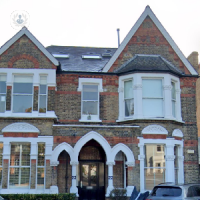Extracorporeal shock wave lithotripsy
What is extracorporeal shock wave lithotripsy?
Extracorporeal shock wave lithotripsy is a non-invasive procedure which treats kidney stones by breaking them up into smaller pieces. It is a safe procedure which has been in use since the 1980s.

What is it for?
The procedure is often used to treat people with stones in the kidney as well as the ureter. It can be less painful and risky than other procedures, and it most effective on stones that are less dense and therefore easier to break apart.
Extracorpoerial shock wave lithotripsy can be offered if:
- Kidney stones are less than 2cm
- The stone has not passed on its own
- You are experiencing severe pain
What does it involve?
Extracorporeal shock wave lithotripsy usually takes half an hour and doesn’t require a hospital stay. You will be asked to lie on an exam table on top of a cushion, either on your front or you back, depending on where the kidney stone is.
The procedure involves passing high-energy shock waves through your body, targeted at the kidney stones, to break them up. The broken-up stones can then leave the body through your urinary system.
Although the procedure involves no surgery, the intensity of the shockwaves might cause some pain, so you might be given a sedative or anaesthetic for the operation.
What is recovery from extracorporeal shock wave lithotripsy like?
After the operation, you will stay for an hour or two to recover and will be asked to drink plenty of liquid to help flush out the stones. It is important to rest for a couple of days after the procedure and avoid driving or drinking alcohol.
Your doctor will schedule a follow-up appointment with you to check that the kidney stone fragments have passed out of your body. If there are more to remove, it might be recommended that you have the procedure again. Finally, it is likely you will need to have regular check-ups to see if there are any new kidney stones.
What are the alternatives to extracorporeal shock wave lithotripsy?
There are a range of alternative treatments for kidney stones which may be more suitable depending on the size and location of the stones:
- Smaller stones can be treated without surgery. Painkillers can be offered while the stone is passing spontaneously.
- Surgery with a ureteroscope is also an option for smaller stones. This involves inserting a thin tube with a camera attached through the ureter the using special tools to break the stone apart.
- If you have a larger stone, and can’t have lithotripsy, a form of surgery known as percutaneous nephrolitotomy might be recommend. This is also sometimes recommended if extracorporeal shockwave lithotripsy wasn’t successful.












